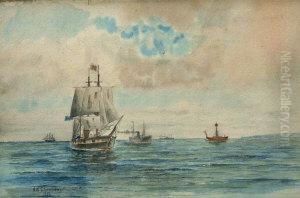Alexander William Crawford Lindsay Paintings
Alexander William Crawford Lindsay, also known as the 25th Earl of Crawford and 8th Earl of Balcarres, was a notable British art historian, collector, and author born on October 16, 1812, in Muncaster, England. He was the eldest son of James Lindsay, 24th Earl of Crawford, and was educated at Eton and Trinity College, Cambridge. Although he was more widely known for his titles and roles in the peerage, Lindsay made significant contributions to the field of art history during the 19th century.
In 1846, Lindsay published 'Sketches of the History of Christian Art', a comprehensive work that became a foundational text in the field of art history. This three-volume set is considered one of his most significant contributions to the subject. His deep interest in art and his extensive travels across Europe allowed him to amass a vast collection of artworks and informed his scholarly writings. He was particularly interested in the early Italian schools of painting, and his collection reflected this passion.
Apart from his work in art history, Lindsay also engaged in politics. He served as a Member of Parliament for Wigan from 1841 to 1852 and for Lonsdale from 1852 to 1855. His political career, however, did not overshadow his dedication to the arts. He was a trustee of the National Gallery in London and played a role in the acquisition of several important artworks for the institution.
Lindsay's legacy extends beyond his written work and his art collection. He was a proponent of artists' rights and was instrumental in the passage of the Fine Arts Copyright Act of 1862, which aimed to protect the intellectual property of artists. His own art collection, which contained works by old masters as well as contemporary artists of his time, was well regarded and contributed to the cultural heritage of Britain.
Alexander William Crawford Lindsay passed away on December 13, 1880, leaving behind a rich legacy as an art historian and collector. His works continue to be referenced by scholars and his art collection, though dispersed, is remembered for its quality and breadth. Lindsay's influence on the study and appreciation of Christian art, in particular, endures through his thorough and insightful examinations of the subject.
